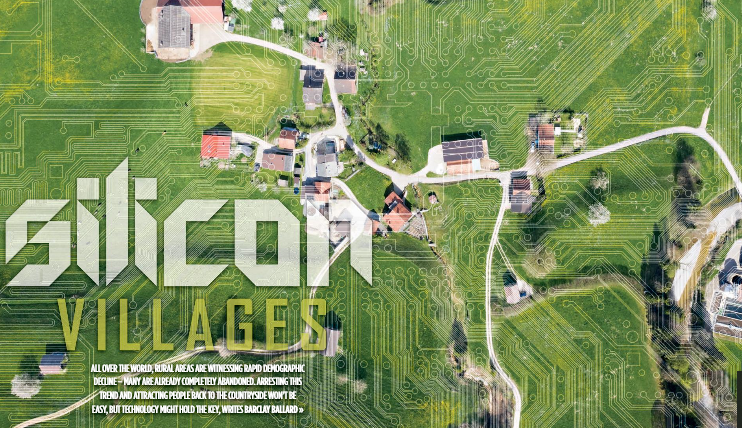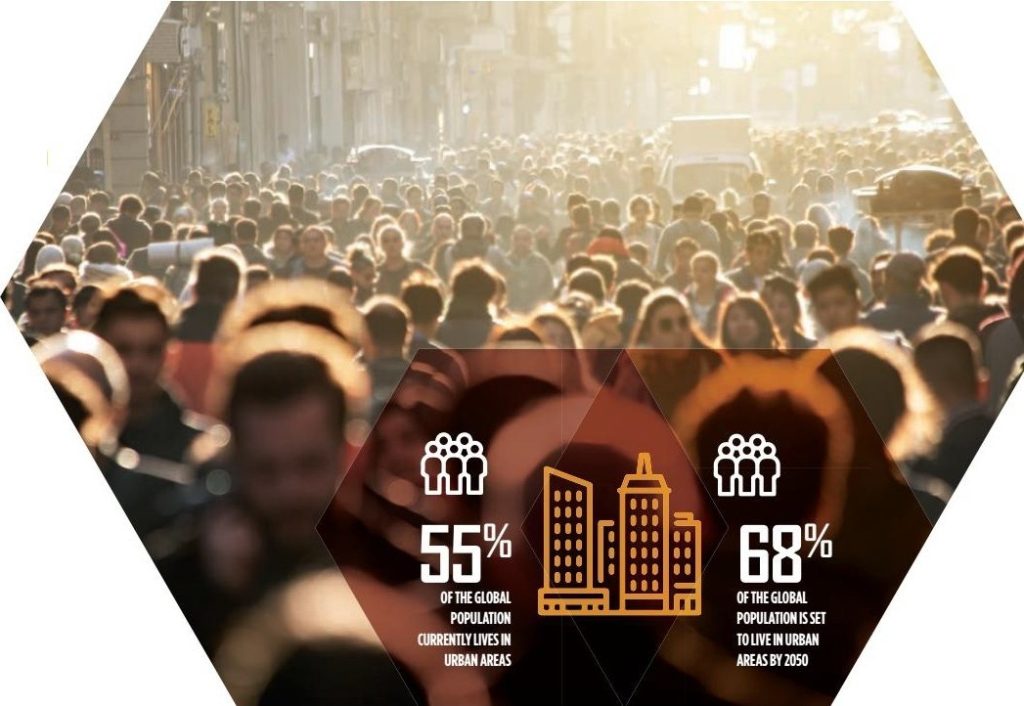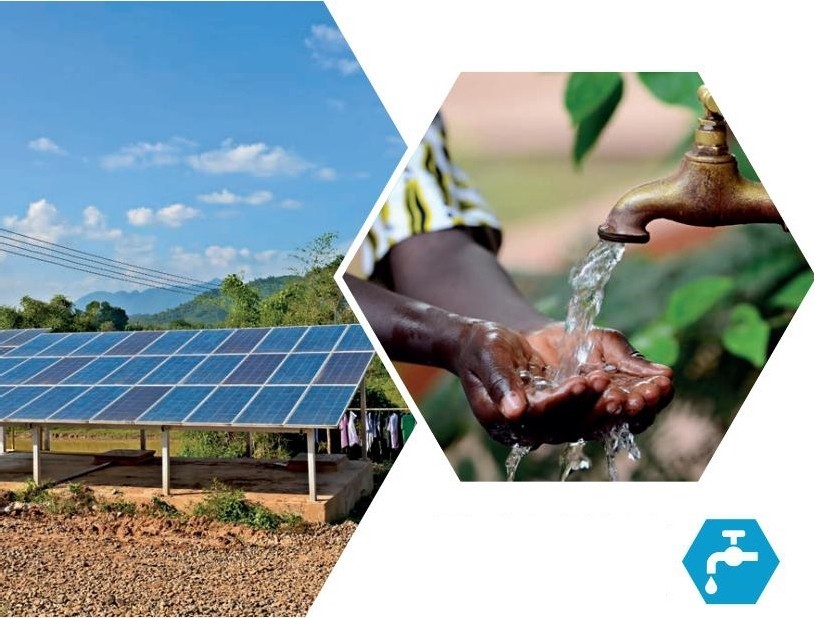
In the not-too-distant future, individuals might hop into their autonomous car, drive to the grocery shop, pickup some goods and leave, without handing over any cash, or even meeting another person. Bins could automatically send a message to waste management teams alerting them that they need to be emptied. Utilities will he able to inform the relevant engineering teams when they require maintenance.
These futuristic features would fit right in alongside the gleaming skyscrapers of New York and Shanghai, but that might not be where they are destined to have the greatest impact. The smart city may be one of tech’s most talked-up innovations, but smart countryside’s are making their way into reality too.
Increasingly, rural areas are being stripped of the communities and infra structure that sustain them as more people move to towns and cities, usually in search of better employment prospects. According to the United Nations, 55 percent of the global population already lives in urban areas, with this figure set to reach 68 per cent by 2050. This increasing concentration is often discussed in relation to urban infrastructure: how will cities cope, with this influx of people? The depopulation of villages and hamlets is an afterthought, if it is thought about at all.
To let rural communities fade away, however would be a mistake. The clean air, gentle pace of life and proximity to nature are all things to be treasured – it’s why many of those moving to cities do so with a heavy heart. In the years to come, however, technology may mean they don’t have to. Around the world, governments and private enterprises are looking at ways of preventing the countryside from being hollowed out.
Put out to pasture
Walking along the abandoned streets of El Alamin, a deserted village in Spain’s Madrid province, is an eerie experience. Only founded in the 1950s, the municipality’s short-lived existence is a microcosm of the global depopulation of rural areas. In its heyday, when the village’s 40 or so houses were occupied by agricultural workers tending to land owned by the Marquess of Comillas, it operated in much the same way as any other rural community. There was a church, a school, a hairdresser and a post office, and the doctor came once a week from the nearby town of Villa del Prado.
But when the agricultural work started to dwindle, things became more difficult for the inhabitants. One by one, they started to leave, moving to Villa del Prado, Madrid or further afield in search of work. By the 2000s, the village of El Alan1in was completely deserted, save for the odd visit by graffiti artists and airsoft players (a military simulation game not dissimilar to paintball).
El Alamin’s story of decline can be found repeated across many Spanish provinces, as well as in Germany, the US and France – in fact, in any nation where agriculture no longer makes up as significant a part of the economy as it once did. Elvira Fafian, the founder of Spanish real estate firm Aldeas Abandonadas – which translates to ‘abandoned villages’ – estimates that there are approximately 1,500 abandoned hamlets in Spain alone. The decision to leave these places would not have been easy, but when already-threadbare services begin to disappear entirely, there is often little choice.
“People living in the rural areas of developing countries face a range of challenges that threaten to isolate them from benefits that can be enjoyed by the rest of their populations,” Paul Marshall, founder and CCO of global Internet of Things (IoT) company Eseye, told The New Economy. “Two major examples are with regards to accessing essential utilities such as water and power, as well as the challenges associated with accessing financial services and payment credit.”

In some parts of the world, are struggling to sustain themselves, with many inhabitants retired or less mobile. Families that remain usually find that younger members leave for the city as soon as they get the chance, eager for change and a bigger social group. In Japan, there are currently an estimated 896 towns and villages that will no longer be viable for living in by 2040. With birth rates low, replacing the ageing population in rural areas is not easy. Policies that encourage population redistribution are essential to counteracting urban migratory flows.
Often, rural communities are victims of a positive feedback loop: people leave, which means essential amenities cannot be sustained, which means more people leave. The cycle simply repeats until entire villages are left empty. Arresting this trend is difficult, as a glut of new jobs is unlikely to suddenly appear within the agricultural sector. New ways of attracting people back to the countryside must be explored instead.
Fortunately, many governments are looking into innovative ways of preventing rural depopulation and attracting newcomers to greener pastures. In China, efforts are underway to construct a number of digital villages’ by 2020, focusing on making sure that 4G internet is available in more than 98 percent of locations. By 2035, the aim is for rural and urban residents to have access to public services of equal standing.
Already, digital solutions are developing at such a pace in China’s rural areas that local economies are thriving. Online retail has allowed people to sell their products and services without having to be located in areas with high customer foot fall. According to the country’s Ministry of Commerce, online retail in rural areas rose 39.1 percent year-on-year in 2017, reaching CNY l.24trn ($173bn). Countrywide, more than 9,8 million online shops were based in villages by the end of 2017. Telemedicine, intelligent security systems and e-government services are also being deployed. The rural-urban living gap is slowly being closed.
Likewise, in Australia, plans are afoot to improve digital inclusion in a country where all settlements outside the major cities are considered rural and remote by the government. The isolation and size of many of the country’s rural communities make delivering essential utilities difficult; as a result, more innovative solutions are being tested. State owned power company Horizon Power, for example, has installed 13 solar and battery technology units in the remote Esperance region, replacing 54km of outdated grid infrastructure.
“In an urban area, utilities are delivered from a central source. In rural areas, however, it’s not quite as simple,” Marshall said. “To achieve sustainable, Jong-term solutions, these utilities must be delivered locally. However, the economics of delivering electricity to small villages of only 50 people, for example, make them far more difficult to implement. But, with technological developments in areas such as water purification or solar energy, this can be overcome. Furthermore, people are now not only enjoying a better quality of life, but these communities are able to source these utilities locally, whether it’s per property or per village.”
Poor access to financial services can also act as a factor driving people away from rural areas. In Akodara, a village of just over 1,000 inhabitants situated in India’s Gujarat state, however, this is not a problem. In 2013, the settlement was ‘adopted’ by India’s largest private bank, ICICI Bank, which quickly set about revamping the infrastructure: a Wi-Fi tower was erected to provide high-speed broadband, and a cashless payment ecosystem was installed. Even at the local market, all transactions now take place through mobile apps, debit cards or online bank transfers. Little wonder, then, that Akodara has earned the title of India’s first digital village.
In remote locations across Asia, Africa and other markets, digital solutions are allowing individuals living outside of major conurbations to gain access to essential services, from banking to medicine. These are just a handful of the communities acting as test cases, trialling whether technology can attract people to a life in closer proximity to the natural world.

Seeking out services
One of the technologies being touted as having huge potential to revamp rural areas is the IoT. IoT devices can drastically improve the quality of life for people living in rural areas, whether they are based in developed or developing countries. Most notably, they can empower local entrepreneurs by providing the services they need to sustain their businesses. This could take the form of financing, communications or logistics. Marshall explained: “Eseye has seen some great examples of how [the] loT has transformed the capabilities of rural areas, with locally generated electricity, for example, paving the way for the emergence of phone-charging shops and even stories of people charging entry to their homes in order to allow visitors to watch major sporting events. The supplier of the equipment is allowed to manage and maintain their assets because of the integration of IoT technology, which provides them with constant performance updates.”
Other IoT applications are delivering critical resources sustainably. SolarNow, a Uganda-based business that aims to transform lives by providing high-quality solar energy solutions through loT integration, is targeting households, small businesses, farmer and corporate customers. As well as bringing power to remote places, SolarNow has also delivered environmental benefits: since it was founded in 2011, the company’s technology has prevented the release of 210,000 tons of greenhouse gas emissions. Additional essential utilities are also being supplied According to the World Health Organisation, a staggering 785 million people globally still do not have access to clean, safe water. Although water systems are continually installed in developing countries, 65 percent break within the first two years as there is no sustainable method of maintaining them.
To overcome this problem, Eseye, Amazon Web Services and London-based start-up eWaterPay have created a system that uses pre-payment technology to ensure the maintenance of water systems. A major element of the solution is machine-to machine technology that provides eWaterPay with up-to-date information on the state of the taps, driving pre-emptive maintenance and helping to solve the widespread problem of broken water systems.
“From our AnyNet SIM to our multi-network SIM card, Eseye’s loT technology allows… devices to connect via cellular networks throughout the world,” Marshall added. “Central to the success of any loT project in a developing country is its ability to be globally connected and highly available. Furthermore, it must be straightforward for non-IoT experts to construction at ground level. At the point of deployment, Eseye can securely and quickly enter a device into the cloud. This helps locals who are setting up the IoT equipment to easily achieve quick configuration.”
In most major cities around the world, essential utilities are taken for granted. When they break, it is simply expected that someone will fix them as a matter of urgency. In rural areas – even those located in some of the richest economies in the world – things are very different. IoT devices, whether developed by cutting-edge start-ups or national governments, can help ensure that even individuals living in sparsely populated areas are never truly cut off.
Don’t count your chickens
Despite recent progress, challenges around getting much-needed technology to rural areas persist. Connectivity is still an issue in many places, which means other potential innovations, including telemedicine and e-banking, can’t be deployed. Maintenance of new solutions is also difficult, particularly when access to rural communities is difficult or inconsistent. Another issue concerns interoperability making sure the various types of software and hardware all work together.
“Collaboration between local suppliers is the key to long-term success for global IoT providers, Marshall noted. “By speaking with these suppliers to create a tailored, cost-effective loT solution, it helps to deliver the most appropriate service possible. After all, by understanding the end consumers in these rural areas and how they will benefit from IoT technology, vendors can create solutions that work out of the box.
As Marshall touched upon, the success of any technological deployment depends on its users. Dialogue with the people who currently live in the countryside will help ensure that any new deployments are fit for purpose and, more importantly, wanted. Better internet connectivity may be a relatively unobtrusive addition to rural life, but that might not be the case for every technological deployment. In France, supermarket chain Casino recently began leaving stores open on Sundays without any members of staff present. The move’s reception wasn’t wholly positive, with locals and unions arguing that it would put pressure on employees to work longer shifts in preparation for the unmanned hours.
In Akodara, individuals involved with the recent digitisation efforts have been keen to talk of ‘rurban’ life, which combines modernity, with rural living. Perhaps that is achievable to an extent, but it will require a delicate balancing act. People move to the countryside to disconnect, not to remain pestered by the 21st
It’s also important to remember that new-fangled gadgets alone might not be enough to attract people back to the countryside. Moving somewhere remote is daunting and a lack of information is often the first cause of reticence. In Spain, for example, Pueblos Vivos, or the Living Villages project, offers advice and guidance to anyone looking to move to rural parts of the country’s Aragon region. Services like these could prove just as useful as any app or sensor in convincing people to give up the convenience of city life.
Living in the countryside is not for everyone, but governments should do more to ensure that individuals do not have to move to the city out of necessity. It is true that digital technologies are once again making isolated locations viable places to call home by providing remote working opportunities, better connectivity and more sustainable energy options, but a shift in mindset regarding how rural areas are viewed still needs to occur.
Rural spaces have traditionally been seen as outmoded relics of a simpler time. If more of them are to survive and flourish, this needs to change. Last year, executives from Microsoft, LinkedIn and Ripple signed up to an initiative that aims to bring high-paying technology jobs to rural Iowa, US. More proposals like this are needed to convince current and prospective residents that provincial locations represent more than just a sepia tinged ideal of how life used to be – they can be forward-looking too.
Original article: The New Economy
Author: Paul Ballard
Eseye brings decades of end-to-end expertise to integrate and optimise IoT connectivity delivering near 100% uptime. From idea to implementation and beyond, we deliver lasting value from IoT. Nobody does IoT better.
